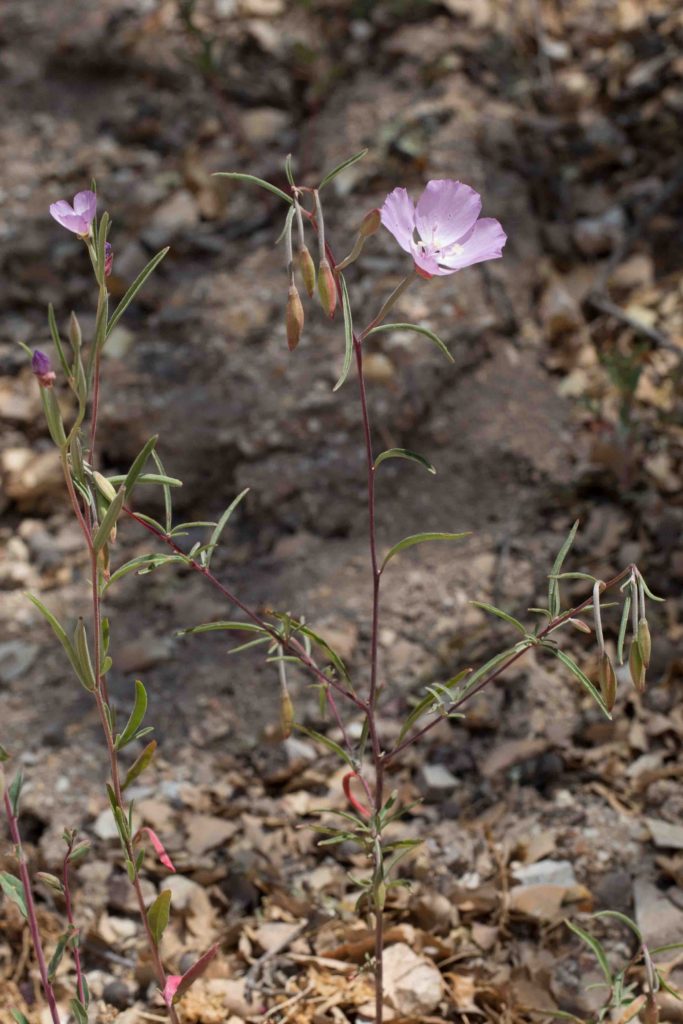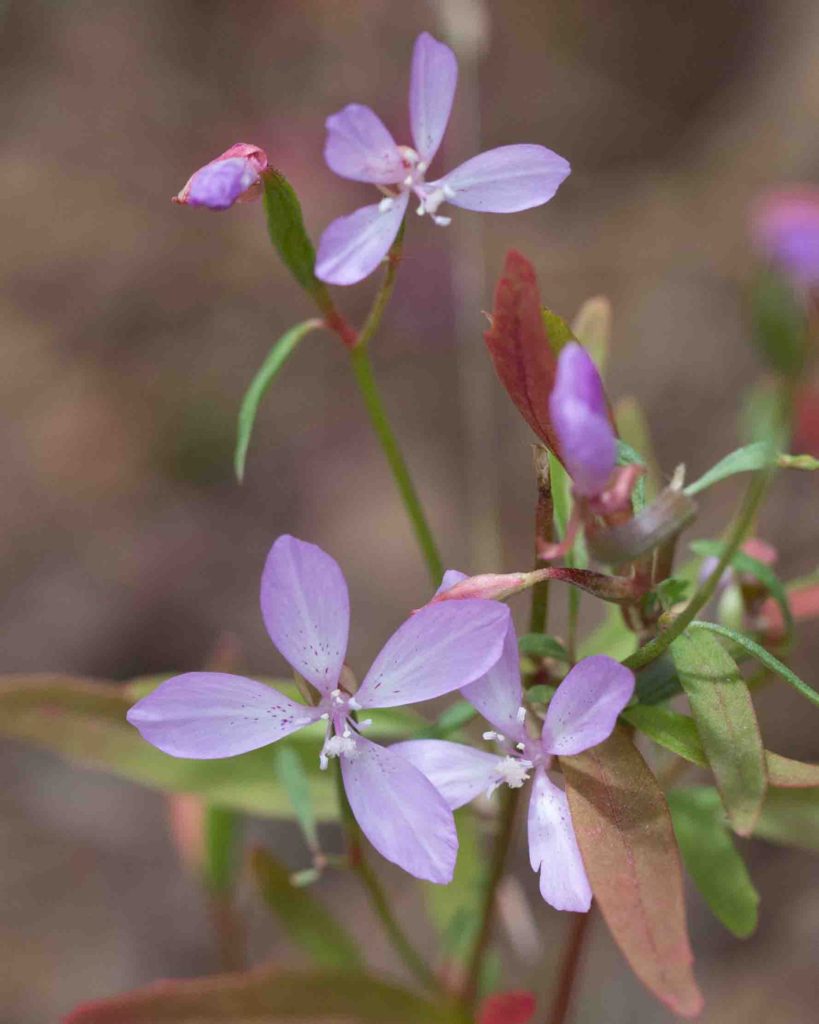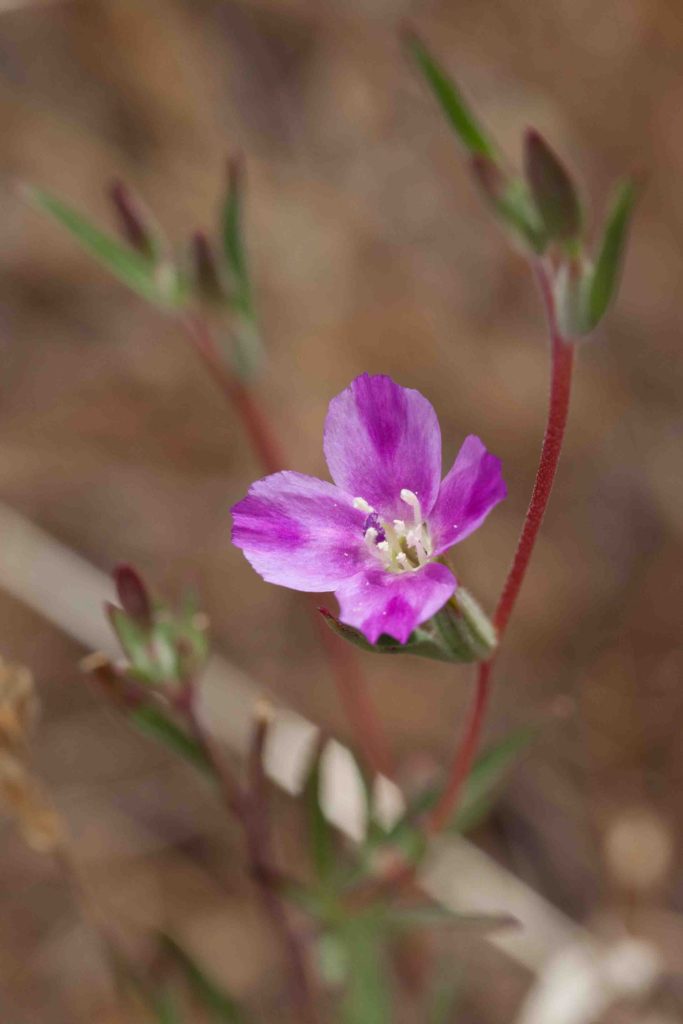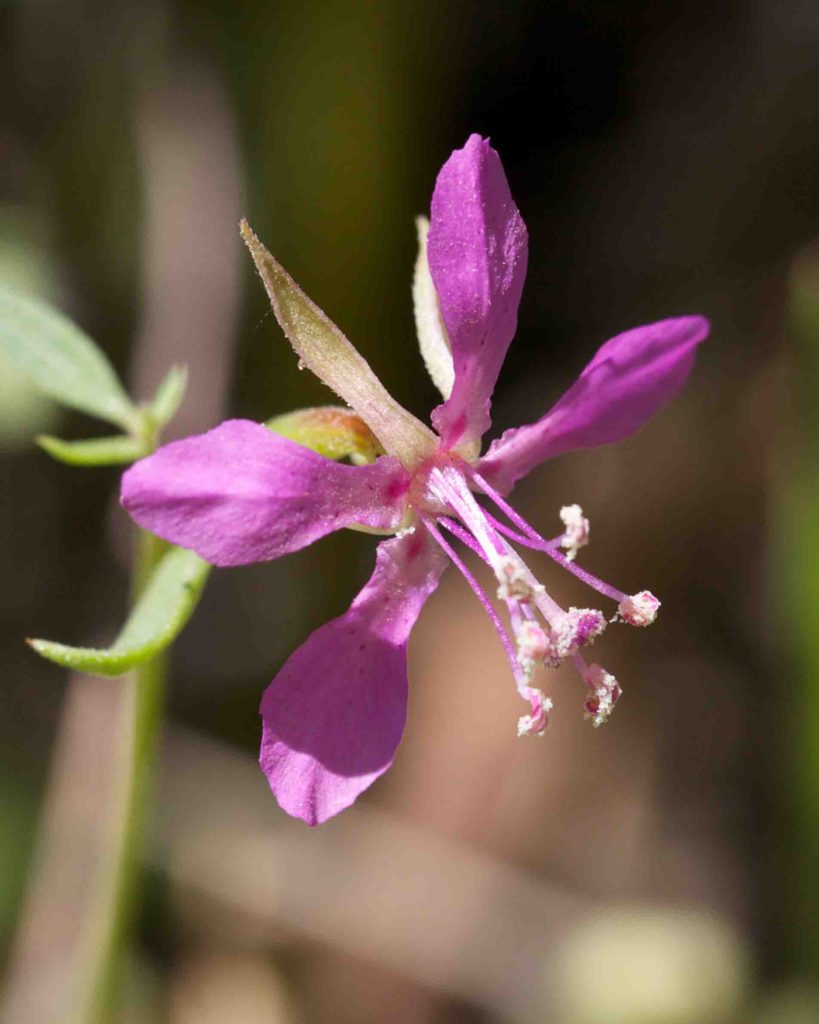Onagraceae: Evening-primrose Family — Clarkia
All members of the Evening-Primrose family have 4-petaled flowers, and many of them are showy. Despite the name, they do not necessarily bloom in the evening. There is a separate family called Primrose (Primulaceae).
Clarkia is a particularly attractive genus with a wide variety of flowers. Some are immediately recognizable, but others require careful attention to such details as whether the buds are upright or nodding, the size and shape of the fruits, whether the stamens are all of the same length, and whether the axis of the inflorescence is straight or recurved. The Four-spot or Winecup Clarkia (Clarkia purpurea subsp. quadrivulnera) deserves a special mention for the variability of its flowers.
Chaparral Clarkia – Clarkia affinis
Blooms:
May–June
Plant Height:
< 80 cm
Flower Size:
Small-medium
Origin:
Native
Habitat:
Woodland openings, chaparral
Notes:
Like Four-spot Clarkia (Clarkia purpurea subsp. quadrivulnera, see below), this has erect buds, and smallish pink to lavender flowers (occasionally deep maroon). There are 8 stamens, similar in length and color. Petals are often red-flecked. It is most easily distinguished by its fruits, which are longer and proportionately narrower (> 9 times longer than wide) than those of Four-spot Clarkia (which are < 8 times longer than wide). This is more common inland, in the south or southeast parts of the county.
Willow-herb Clarkia – Clarkia epilobioides
Blooms:
Apr–May
Plant Height:
< 70 cm
Flower Size:
Small-medium
Origin:
Native
Habitat:
Shaded places
Notes:
A small plant with smallish, obovate petals. They begin white, then fade to pink with age, but not flecked with purple. Buds are nodding. Leaves are linear, to narrowly lanceolate or oblanceolate. Sepals remain fused in 4s or 2s, often reddish in color.
Jolon Clarkia – Clarkia jolonensis
Blooms:
Apr–June
Plant Height:
< 60 cm
Flower Size:
Small-medium
Origin:
Native
Rare or endangered:
Yes – 1.b2
Habitat:
Dry chalk-rock shale slopes near Jolon
Notes:
Found only near Jolon, this could easily be mistaken for Lewis’ Clarkia (Clarkia lewisii, see below). But it can be distinguished by the absence of a red line at the base of the petals. Also, its inflorescence is erect rather than recurved. Buds are reflexed, becoming erect as the flower opens. The outer anthers are longer and darker than the inner ones.
Lewis’ Clarkia – Clarkia lewisii
Blooms:
Apr–May
Plant Height:
< 70 cm
Flower Size:
Medium–large
Origin:
Native
Rare or endangered:
Yes – 4.3
Habitat:
Coastal scrub, woodland, chaparral
Notes:
This common clarkia has pink to lavender petals, 1–3 cm long. They usually have pink speckles, the color fading to white down near the base. Also, there is a dark pink or red line across the base of the petal, forming a kind of square. Buds are nodding. The outer anthers are longer and darker than the inner ones. The entire base of the petals is occasionally deep crimson, similar to Ruby Chalice Clarkia (Clarkia rubicunda, see below), but the plant can be distinguished by its nodding buds, and the two different forms of its anthers. Photo #2 by CJH.
Waltham Creek Clarkia – Clarkia modesta
Blooms:
Apr–May
Plant Height:
< 70 cm
Flower Size:
Small-medium
Origin:
Native
Habitat:
Shaded places
Notes:
This is similar to Ramona Clarkia (Clarkia similis, see below). Both have nodding buds and diamond-shaped to oblanceolate petals. The outer anthers are longer and darker than the inner ones. Fruits are long, slender and 8-grooved. The main differences between the two species is in the size of the petals (this has petals that are 8–12 mm) and their coloration: this has pink petals, which are not lighter towards their base.
Four-spot / Winecup Clarkia – Clarkia purpurea subsp. quadrivulnera
Blooms:
Apr–Aug
Plant Height:
< 100 cm
Flower Size:
Small-medium
Origin:
Native
Habitat:
Open grassy or shrubby places
Notes:
This is the most common of our clarkias, and its flowers are quite variable in their appearance. While some are almost white, most are pink. They range from very pale to very dark; all generally have a darker blotch on the margins of the petals, hence the common name Four-spot Clarkia. These are shown in the top row of 4 photos. Others, although the same species, are pure deep maroon; these are commonly called Wine-cup Clarkia, and are shown in the second row of 4 photos.
Like Chaparral Clarkia (Clarkia affinis, see above), this species has erect buds and flowers, with 8 stamens similar in length and color. The stamens are sometimes useful in distinguishing flowers that may look like a small Lewis’ Clarkia (Clarkia lewisii, see above). This and Chaparral Clarkia are most easily distinguished by their fruits; this has fruits which are shorter and proportionately fatter (< 8 times longer than wide) than those of Chaparral Clarkia (> 9 times longer than wide). Photos #4, 6 and 7 by CJH.
Diamond Clarkia – Clarkia rhomboidea
Blooms:
Mar–Sept
Plant Height:
< 100 cm
Flower Size:
Small-medium
Origin:
Native
Habitat:
Yellow pine forests & other woodland
Notes:
Like Elegant Clarkia (Clarkia unguiculata, see below), this has erect stems with flowers borne at various points along the stem. Buds are nodding. Petals are pink to lavender, narrowly ovate to diamond-shaped, distinguished by the broad claw at the base of the petals and the presence of distinct lobes on the claw. Fruits are 4-grooved. Photo #4 by CJH.
Ruby Chalice Clarkia – Clarkia rubicunda
Blooms:
May-Aug
Plant Height:
< 150 cm
Flower Size:
Medium–large
Origin:
Native
Habitat:
Woodland openings, chaparral near coast
Notes:
This is sometimes called Farewell to Spring, although that can cause confusion with the often-cultivated Clarkia amoena. This has rose-pink to lavender petals, obovate to fan-shaped, generally with a prominent reddish zone at the base. It can be mistaken for Lewis’ Clarkia (Clarkia lewisii, see above), which is occasionally found with deep red petal bases, but there are several differences. First, Ruby Chalice Clarkia has erect, not nodding buds (see photo #4). Second, its eight anthers are all alike (Lewis’ Clarkia has two contrasting sets of 4 anthers). Third (and harder to see), the hypanthium in Lewis’ Clarkia has a ring of hairs at its base, the Ruby Chalice Clarkia lacks this feature. Photo #3 by CJH.
Ramona Clarkia – Clarkia similis
Blooms:
Apr–June
Plant Height:
< 90 cm
Flower Size:
Small-medium
Origin:
Native
Habitat:
Dry slopes, mainly interior
Notes:
This is very similar to Waltham Creek Clarkia (Clarkia modesta, see above). Both have nodding buds, and diamond-shaped to oblanceolate petals. The outer anthers are longer and darker than the inner ones. Fruits are long, slender and 8-grooved. The differences between them are in 1) the size of the petals (this has petals that are 6–10 mm), and 2) the petal color (this has white petals, or pale pink shading lighter towards their base), and are generally dark-spotted or -flecked). Thanks to a friend for use of the photo.
Redspot Clarkia – Clarkia speciosa subsp. speciosa
Blooms:
May–July
Plant Height:
< 60 cm
Flower Size:
Large
Origin:
Native
Habitat:
Dry places, woodland
Notes:
This is a striking clarkia, immediately recognizable with its dark purple-red or lavender flowers, generally with red spots. The plant is decumbent to erect. The stigma is prominently exserted beyond the anthers. Buds are erect. The fruits are conspicuously 8-grooved or -ribbed. The stem is covered with short, soft hairs. Branches on well-developed plants can be numerous, but few-flowered.
Elegant / Canyon Clarkia – Clarkia unguiculata
Blooms:
Apr–Sept
Plant Height:
< 100 cm
Flower Size:
Large
Origin:
Native
Habitat:
Dry slopes
Notes:
A very common clarkia, immediately recognizable by its spreading petals that are triangular or diamond-shaped, abruptly narrowing to a slender claw. The flowers grow along the length of tall stems, sometimes in profusion, creating spectacular displays. The typical color is dark pink with deep crimson sepals, but it can also be found in salmon pink, red and even white. The outer anthers are longer and darker than the inner ones. Photo #4 by CJH.










































